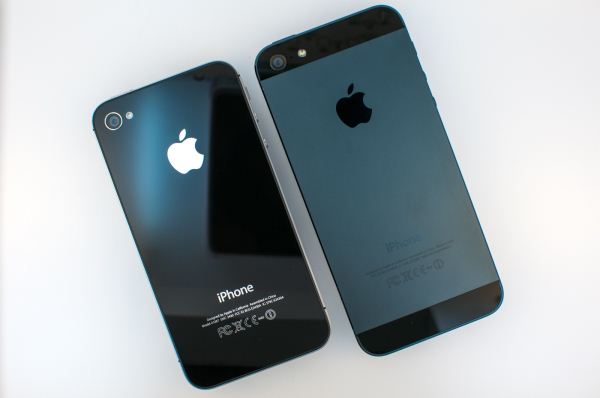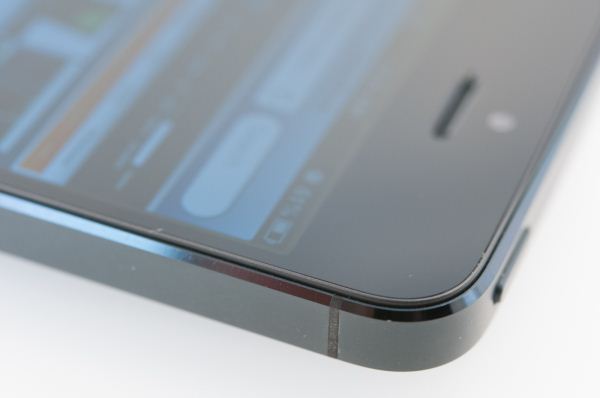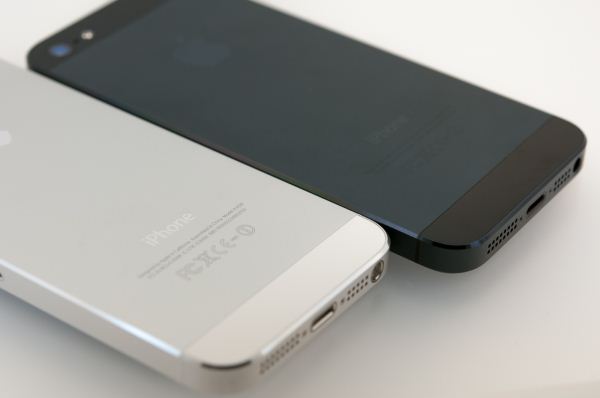The iPhone 5 Review
by Anand Lal Shimpi, Brian Klug & Vivek Gowri on October 16, 2012 11:33 AM EST- Posted in
- Smartphones
- Apple
- Mobile
- iPhone 5
Design
Section by Vivek Gowri
The iPhone 4, when it launched, represented a clean break for Apple's industrial design. It replaced the soft organic curvature of the iPhone 3G/3GS with a detailed sandwich of metal and glass, something that arguably brought the feel of a premium device to a new level. Obviously, Apple had their fair share of issues with the design initially, and nothing could match the sinking feeling of dropping one and shattering the glass on the front and back simultaneously, but it was a small price to pay for the jewel-like feel of the device. Combined with the (at the time) incredible pixel density of the then-new Retina Display, the iPhone 4 was a revolution in hardware design. The chassis has aged remarkably well over the last two-plus years, so naturally it's a hard act to follow.
The 5 keeps a similar design language to the 4, keeping roughly the same shape as before but with a taller and thinner form factor. At first glance, the 5 actually looks almost the same as the 4, with an unbroken glass front face, prominent corner radiuses, the familiar home button, a rectangular cross-section, and metallic sides with plastic antenna bands. However, those metallic sides are part of an anodized aluminum frame that makes up a majority of the body, and that's where the industrial design diverges from the 4 and 4S.
In contrast to the predominantly glass body of the previous generation iPhone, the 5 is almost entirely aluminum other than the glass front face and two small glass windows at the top and bottom of the back. It's a return to the original iPhone/3G/3GS-style of construction, with the front glass clipping into a unibody chassis. It's a significant departure from the 4 and 4S, where the stainless steel band in the center was the main housing that the front and rear panels clipped into. That was pretty radical way of doing things, so it's not all that surprising to see Apple revert to a more conventional and less complex method for the 5.
The aesthetic is actually pretty awesome, especially in the black version. The combination of black glass and off-black aluminum (Apple is calling it slate) gives the 5 an almost murdered out look that's three parts elegant and one part evil. The white and silver model has a classy look that's much friendlier in appearance than the black one. The color schemes and overall design aesthetic remind me of the Dell Adamo, one of my favorite notebook designs of all time. The similarities may be purely coincidental, but it's interesting to note nonetheless and should give you an idea of how premium the industrial design is.
All three previous iPhone body styles had very similar dimensions, so the biggest question with the 5 was how much the larger display would do to change that. Unlike many Android manufacturers, Apple still believes in things like small pockets, small hands, and one-handed smartphone usage. With the 5 being vertically stretched but no wider than the previous iPhones, the biggest impact on in-hand feel is actually the thinner body. If you're used to a larger Android or Windows device, the change seems radical, but even compared to the 22% thicker iPhone 4S, it feels a good deal smaller.
It's not just the minimized z-height though, the 25% weight loss is definitely also a factor. Even a few weeks later, I still find it striking how much less substantial it feels than the 4 and 4S. The densely-packed glass body just had a reassuring weight to it that the 5 simply lacks. But as you get used to the new form factor, you realize how far Apple is pushing the boundaries of ultrathin design. When the 4th generation iPod touch came out, I told Brian that I wanted an iPhone with that form factor - well, the 5 is essentially there (0.3mm thicker and 11 grams heavier, but close enough). It's pretty impressive to think about. If you thought the 4S was one of the best phone designs on the market in terms of aesthetics and build quality, the iPhone 5 just pushes that advantage further.



















276 Comments
View All Comments
TrackSmart - Wednesday, October 17, 2012 - link
Shouldn't the battery life on the Verizon Galaxy SIII with LTE be higher than shown? That result bunches up with the 3G scores rather than the LTE scores. I wonder if the "LTE" listing is a typo.It's also a bit surprising how much of a difference the connection speed makes (3G vs 4G LTE) for the battery life tests. Are you guys really testing differences in power efficiency under typical use? Or have you, inadvertently, created a strange test of air interface throughput/watt - which would vary based on signal strength and network speed, but not based on the main device power draw under typical browsing (i.e. screen + intermittent CPU usage spikes).
I would have guessed that that screen power draw would be the largest cause for differences between handsets, not the air interfaces on the new devices, now that LTE is no longer a power hog.
phillyry - Sunday, October 21, 2012 - link
If it's anything like the Telus GS3 up here in Canada than it's not likely a typo. My brother has it and it tanks so bad on LTE that he keeps it turned off. Same thing with NFC btw. Two major selling features of the GS3 that went down the tubes in reality.Skidmarks - Wednesday, October 17, 2012 - link
I've got to hand it to Apple, if nothing else they sure know to market their rubbish.Freakie - Wednesday, October 17, 2012 - link
I haven't seen the 5 in person, but every time I see a picture of the front of it, I swear its design echos Samsung devices quite a bit. If any light hits it directly then it looks off-black, at least in the pictures, to the point of looking like Samsung's Pebble Blue color back when it was a bit darker (Samsung Impression).They got rid of the band around the phone and just have a slanted surface which when looking at pictures taken 8 inches away from the phone, has it's sharp "edges" that it slants to become one smooth transition. Reminds me a lot of the GSII's front.
Now I'm not a fan of any design litigations going either way, but I've never seen a Samsung device echo the looks of Apple's devices quite as much as the iPhone 5 echos a number of Samsung's design flairs that they've been using for a while.
Just my two cents xP
kmmatney - Wednesday, October 17, 2012 - link
Are you kidding me. Look at how much the original; Samsung Galaxy copies the iPhone 3G. Same with the Galaxy SII.See for yourself
3G versus SGI
https://encrypted-tbn1.gstatic.com/images?q=tbn:AN...
and 4S versus SGII
http://www.gizmowatch.com/entry/comparing-mights-i...
medi01 - Wednesday, October 17, 2012 - link
Wow, SGII and 4S have the same screen ratio, you shameless iScum...Freakie - Wednesday, October 17, 2012 - link
Oh I never said that Samsung hasn't produced a phone similar to an iPhone, though your second picture is pretty ridiculous (that's the SGI not SGII) which came out several months before the 4. Not only that but the picture its self is most definitely shot/edited in a way to make them as similar as possible.My complaint is just Apple doing something very different than normal, and echoing someone else for a change. Usually they seem to go for something different than the rest and the iPhone 5 most definitely does not come anywhere near that.
steven75 - Wednesday, October 17, 2012 - link
This is probably the most silly comment I've read among any iPhone reviews. iPhones have always been similar overall since the revolution if 2007 and now you are seriously making the claim this looks more like a Samsung device?/smh
MNSoils - Wednesday, October 17, 2012 - link
Apple has an interesting story here and your group did a wonderful job telling it.On the 2 graph of the "Increased Dynamic Range" page, the idle power for the Tegra 3 SOC after finishing the Kraken benchmark seems awfully high for just the companion core. Does more time have to elapse before Android reverts to the companion core? Is the companion core not that power efficient (power-gated, etc.)? Does Android revert to the companion core?
colonelclaw - Wednesday, October 17, 2012 - link
Thanks for a terrific article. It's just a shame that about 75% of the comments will be by people who either love the device or hate it, and nothing in this carefully researched and written appraisal will make them change their minds either way.How did we get to this? Actually, don't answer, that would turn into an irrelevant pissing match too.